

Rocket Men. Skyscrapers and giant yachts are so passé.
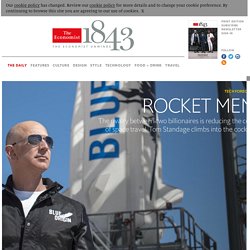
These days a tech billionaire who wants to assert his wealth, power and, er, manhood needs a rocket to play with – and the bigger the better. Two billionaires in particular have been tussling lately over who has the more impressive equipment: Jeff Bezos (above), the boss of Amazon, and Elon Musk (below), the boss of SpaceX and Tesla. As childish as their public sparring appears, the consequences are tangible – and deserve to be widely celebrated. Bezos made his fortune through Amazon, the retailer whose spookily accurate algorithms know what you will buy next even before you do, and whose cloud-computing systems quietly power much of the internet.
With his vast but hidden power and characteristic laugh, it’s surely only a matter of time before Bezos is used as the model for a Bond villain. Kardashev Scale: The Kinds of Alien Civilizations in Our Universe. The Oligodynamic Effect: How Some Metals Kill Off Bacteria. A recent story from blog Mind the Science Gap got us thinking about the pitfalls of overusing antibacterial soap.

The active bacteria killer in those soaps, Triclosan, is just about everywhere these days--it shows up in everything from pizza cutters to toothpaste. It's possible that Triclosan isn't entirely healthy for us; worse, overuse may potentially be making some bacteria immune to Triclosan, and that's a whole new mess. But overuse of Triclosan doesn't mean we should stop caring about hygiene and let any old bacteria get us sick--we simply need to remember that there are other solutions out there that can kill bacteria. Like brass doorknobs, for example. Fact: Frequently touched surfaces (especially in public places) are like safe havens for bacteria.
Photo via Flickr user Brian J. We could colonize the moon at an initial cost of only $10 billion. (Updates article to add other costs of colonizing the moon.)

What if I told you there’s no reason we couldn’t set up a small base on the moon by 2022 without breaking the bank? Reaching the moon would cost about $10 billion — estimates range from $7 billion and $13 billion — with an additional $28 billion to $52 billion being spent on the construction of base-related structures. That is considerably less than a previous price of $100 billion-plus when technology was less advanced and more expensive. To put that cost in perspective, one U.S. aircraft carrier has a price of $13 billion. Pluto - Educational facts and the history of Pluto. Pluto orbits beyond the orbit of Neptune (usually).

It is much smaller than any of the official planets and now classified as a "dwarf planet". Pluto is smaller than seven of the solar system's moons (the Moon, Io, Europa, Ganymede, Callisto, Titan and Triton). Planet Profile orbit: 5,913,520,000 km (39.5 AU) from the Sun (average)diameter: 2372 kmmass: 1.303e22 kg. Shape of the universe. The shape of the universe is the local and global geometry of the Universe, in terms of both curvature and topology (though, strictly speaking, the concept goes beyond both).
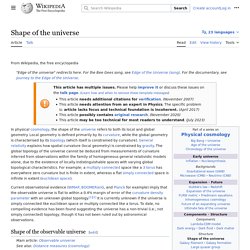
The shape of the universe is related to general relativity which describes how spacetime is curved and bent by mass and energy. There is a distinction between the observable universe and the global universe. The observable universe consists of the part of the universe that can, in principle, be observed due to the finite speed of light and the age of the universe. The observable universe is understood as a sphere around the Earth extending 93 billion light years (8.8 *1026 meters) and would be similar at any observing point (assuming the universe is indeed isotropic , as it appears to be from our vantage point). According to the book Our Mathematical Universe, the shape of the global universe can be explained with three categories:[1] There are certain logical connections among these properties. Ωmass ≈ 0.315±0.018. Kepler-444: An Ancient System with Five Planets. MOFFETT FIELD, Calif. - NASA's Kepler mission scientists have discovered a new planetary system that is home to the smallest planet yet found around a star similar to our sun.
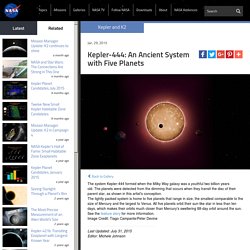
The planets are located in a system called Kepler-37, about 210 light-years from Earth in the constellation Lyra. The smallest planet, Kepler-37b, is slightly larger than our moon, measuring about one-third the size of Earth. It is smaller than Mercury, which made its detection a challenge. Ceres Spots Continue to Mystify in Latest Dawn Images. Dwarf planet Ceres is located in the main asteroid belt, between the orbits of Mars and Jupiter, as illustrated in this artist's conception.

Credits: ESA/ATG medialab This graph shows variability in the intensity of the water absorption signal detected at Ceres Credits: Adapted from Küppers et al. Scientists using the Herschel space observatory have made the first definitive detection of water vapor on the largest and roundest object in the asteroid belt, Ceres. Plumes of water vapor are thought to shoot up periodically from Ceres when portions of its icy surface warm slightly. Herschel is a European Space Agency (ESA) mission with important NASA contributions. Sounds of Space: New 'Chorus' Recording By RBSP's EMFISIS Instrument.
Saturn's Hexagon Storm.
Charon Poses a Geomorphic Riddle: How do You Make a Mountain in a Moat? Stuart Mitchell - Saturn's Hexagon Explained with Cymatics. JkJ2tap.jpg (JPEG Image, 906 × 782 pixels) 1ARI3QO.png (PNG Image, 1280 × 1280 pixels) - Scaled (78%) There's a Dark "Anti-Polar Cap" on Pluto's Moon Charon. Your Guide to Pluto: Everything We've Learned From New Horizons So Far. YsaLqAf.gif (GIF Image, 500 × 500 pixels) The size of it all. Pluto is to the right of Neptune : space. These photos from NASA's Cassini probe don't even look real : pics.
Enceladus. In 2005, the Cassini spacecraft started multiple close flybys of Enceladus, revealing its surface and environment in greater detail.
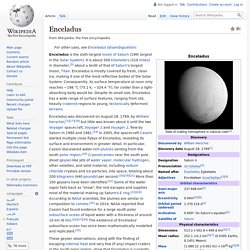
In particular, Cassini discovered a water-rich plume venting from the south polar region of Enceladus.[16] Cryovolcanoes near the south pole shoot geyser-like jets of water vapor, other volatiles, and solid material, including sodium chloride crystals and ice particles, into space, totaling approximately 200 kilograms (440 lb) per second.[15][17][18] Over 100 geysers have been identified.[19] Some of the water vapor falls back as "snow"; the rest escapes, and supplies most of the material making up Saturn's E ring.[20][21] According to NASA scientists, the plumes at Enceladus seem similar in chemical makeup to comets.[22] In 2014, NASA reported that Cassini found evidence for a large south polar subsurface ocean of liquid water within Enceladus with a thickness of around 10 km.[23][24][25] Discovery and naming[edit] Orbit[edit] Physical characteristics[edit]
Researchers working with data from NASA's Cassini spacecraft have discovered one way Saturn's magnetosphere changes with the planet's seasons. The finding provides an important clue for solving a riddle about the planet's naturally occurring radio signal. NASA Posts a Huge Library of Space Sounds, And You're Free To Use Them. Space is the place.

Again. And SoundCloud is now a place you can find sounds from the US government space agency, NASA. In addition to the requisite vocal clips (“Houston, we’ve had a problem” and “The Eagle has landed”), you get a lot more. There are rocket sounds, the chirps of satellites and equipment, lightning on Jupiter, interstellar plasma and radio emissions. And in one nod to humanity, and not just American humanity, there’s the Soviet satellite Sputnik (among many projects that are international in nature). Many of these sounds were available before; I’ve actually used a number of them in my own music. Another thing: you’re free to use all of these sounds as you wish, because NASA’s own audio isn’t copyrighted. Eerie Sounds of Saturn's Radio Emissions. Eerie Sounds of Saturn's Radio Emissions + Play sound of Saturn's radio emissions, which have changing frequencies Saturn is a source of intense radio emissions, which have been monitored by the Cassini spacecraft.
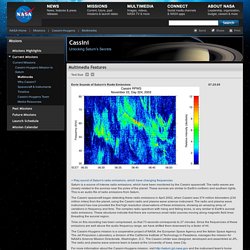
The radio waves are closely related to the auroras near the poles of the planet. These auroras are similar to Earth's northern and southern lights. This is an audio file of radio emissions from Saturn. 123163main_cas-skr1-112203. 'Double star' moment for Jupiter and Venus in the night sky. Tuesday night, Jupiter and Venus will culminate a month-long dance with what astronomers say will be a dazzling display, appearing just a fraction of a degree apart from one another in the night sky -- a show that some astronomers say could account for the "Star of Bethlehem" mentioned in the Bible.
"To the eye they'll look like a double star," Sky & Telescope editor Kelly Beatty said on the magazine's website. To see the lineup, look to the west-northwest shortly after sunset. This isn't a particularly rare event; such conjunctions are fairly frequent, thanks to how Earth and the two planets line up in the solar system, according to Sky & Telescope. Saturn's hexagon recreated in the laboratory. Posted by Emily Lakdawalla Topics: pretty pictures, Cassini, atmospheres, explaining science, Saturn A lot of readers have expressed interest in the origin of Saturn's north polar hexagon.
Saturn's Polar Vortex Stuns in New Photo. Forget Saturn's rings. Saturn's Polar Vortex Stuns in New Photo. Saturn was the first Sun? (Electric Universe) Well, that doesn't explain the Native American myths about different suns: Given how much system 2 narration going on in all facets of our past/current myths, religion, science, assuming old texts as authority for literal translation is tricky.For example Velikovsky thought venus came out of jupitor infact it came from that direction ( as per C's). If we think Velikovsky translated correctly , then we have to assume that who ever wrote the texts doesn't know about the comet cluster and cycles can happen. Saturn Theory. The Saturn Myth. Saturn's hexagon. Saturn - North polar hexagon and vortex as well as rings (April 2, 2014). Andromeda Galaxy. Saturn's Moon Enceladus Has a Warm Ocean, Could Have Life.
Move over, Europa. Exact Solutions of the Space-Time Fractional Bidirectional Wave Equations Using the -Expansion Method. The Rise and Fall of Ziggy Stardust and the Spiders from Mars. Wright brothers. The Wright brothers, Orville (August 19, 1871 – January 30, 1948) and Wilbur (April 16, 1867 – May 30, 1912), were two American brothers, inventors, and aviation pioneers who were credited[1][2][3] with inventing and building the world's first successful airplane and making the first controlled, powered and sustained heavier-than-air human flight, on December 17, 1903. From 1905 to 1907, the brothers developed their flying machine into the first practical fixed-wing aircraft. Although not the first to build and fly experimental aircraft, the Wright brothers were the first to invent aircraft controls that made fixed-wing powered flight possible. Up_goer_five.png (PNG Image, 740 × 3214 pixels) Will a magnet work in outer space.
Space elevator. Manipulating and Harnessing the Schumann Resonance. Brian David Andersen. ESA Asteroid Deflection. Breaking glass with sound? I want to break rock instead. NASA ADS: Resonance and elastic nonlinear phenomena in rock. SAO/NASA ADS Physics Abstract Service. How Do You Find The Resonance Frequency of A Rock? Black Hole Sound Waves. Have You Heard About B Flat? : Krulwich Wonders...